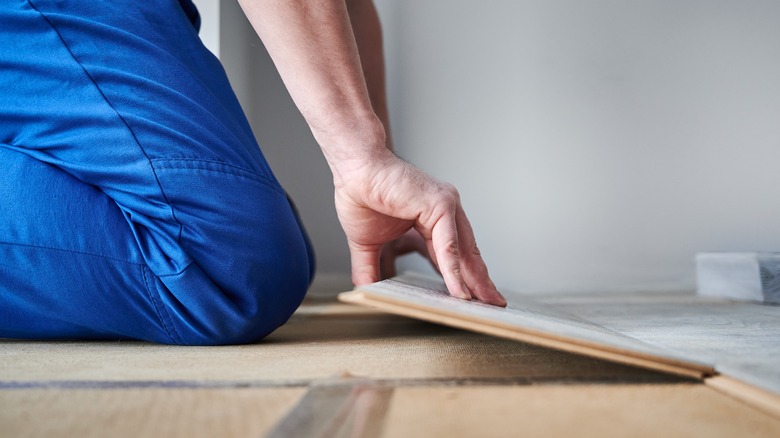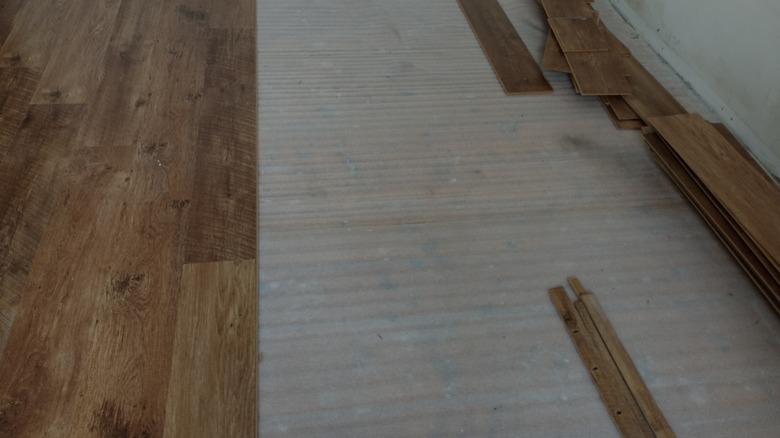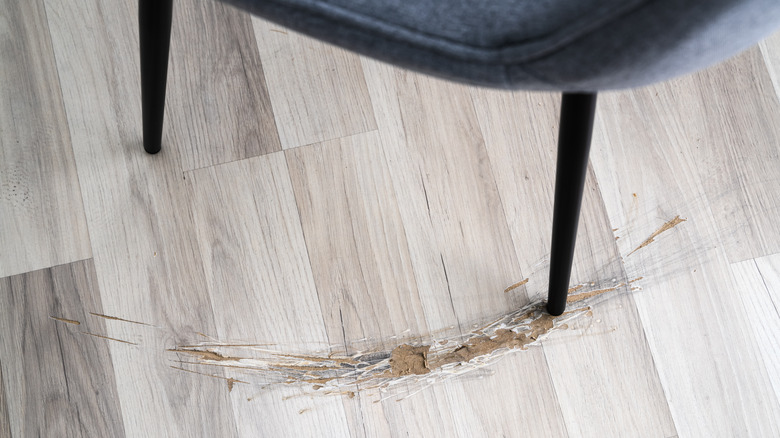You Might Be Able To Reuse Those Laminate Floors You're Removing
When you replace a floor that's in pretty good shape, it can feel wasteful to just toss the old materials in the dumpster. Selling them or even giving them away in online marketplaces is an option if you have the room to store them. And you can always repurpose the floor for craft projects — maybe decoupage wall art or coasters. Who doesn't need 12,000 coasters? But if you have a room of the right size that needs a floor, why not consider repurposing your floating click-together laminate flooring? If you're removing it because the material is showing signs of needing replacement, you'll obviously have to think through whether it will work in the new area.
Floating floors often come up in easily reusable boards, but you'll need to take some extra care removing the old pieces to keep them intact. You might also have some difficulty finding a certified installer to handle a laminate reuse project for you. These professionals rely on the protection afforded by the quality of new products, and particularly rely on manufacturer's warranties to keep them out of hot water with homeowners when an installation goes badly. Don't be surprised if your usual go-to isn't thrilled about installing a sub-par product, given this extra risk. And don't expect a discount, since it's actually more difficult to install used laminate than new.
How to decide if your old flooring is reusable
While you're in the planning stages, think carefully about whether you have enough materials for your reuse project. You'll discard a lot of flooring during this process, so it's not a given that you'll have enough leftover laminate from a 500-square-foot room to floor a 300-square-foot room. You should also plan for a higher-than-usual rate of waste. Typical laminate flooring installation requires around 10% waste, but you can expect to need a much higher percentage of reused flooring — maybe 20-25%.
So, which flooring is worth saving? If the wear layer is worn through or significantly damaged on too many boards, the pieces might not be worth reusing for a room in your home, but they might still be useful in a shed or other outbuilding. Don't try to save any material that's cut around objects. You might encounter a few boards that have been glued, especially on uneven subfloors and in areas like doorways and other transitions where the boards might not have been well-secured on the first or last row during construction. These glued pieces are unlikely to be useful, but use your own judgment.
Because the interlocking edges are milled into the comparatively fragile fiberboard core of the laminate flooring, they're susceptible to damage during installation and removal. You don't have to discard pieces with damaged edges as they can be used in a pinch, but it probably wouldn't be worthwhile to wrestle with a lot of damaged boards.
Removing and reusing laminate flooring
When you remove the old laminate flooring, inspect each piece for damage, and sort the acceptable ones into five or six piles. You'll want one pile for pieces cut for use on the left-hand side of a row, and another pile for pieces cut for the right-hand side of a row. Make three or four piles for the remaining boards, sorted by board length. Each row's start and end boards can only be used as start and end boards, since one interlocking edge is missing. Place them in your room so they're within easy reach when installing the first and last boards of your new rows.
If you're attempting to reuse laminate with the occasional damaged interlocking edge, it's useful to have a few extra tools on hand. A miniature wood plane, such as a finger plane or trimming plane, can be useful to remove broken remnants of the interlocking mechanism to make installation easier. Harbor Freight sells a $14.99 set of three miniature brass planes that are suitable for this. Also keep some wide painter's tape and wood glue on hand to secure boards with non-functioning interlocking edges. Simply run a bead of glue down the top of the tongue, fit the adjacent board, then tape them together to avoid separation while you're finishing the installation. Keep a roll of duct tape on hand, too, for the hack that lets you pull together flooring that separates during laminate installation.



